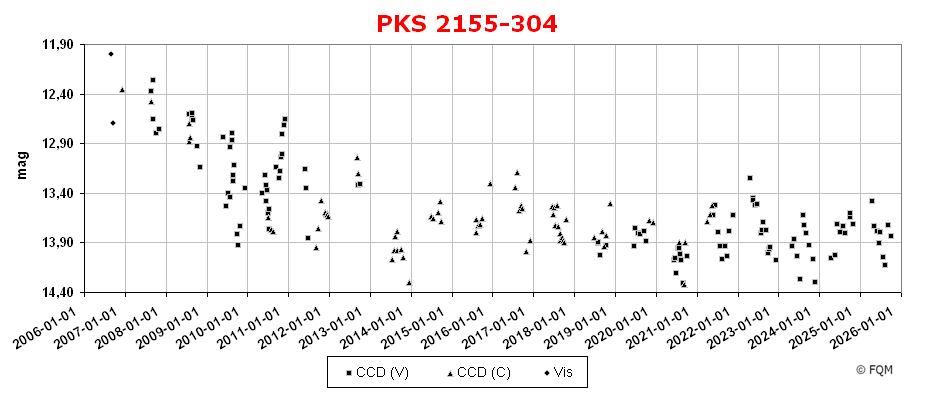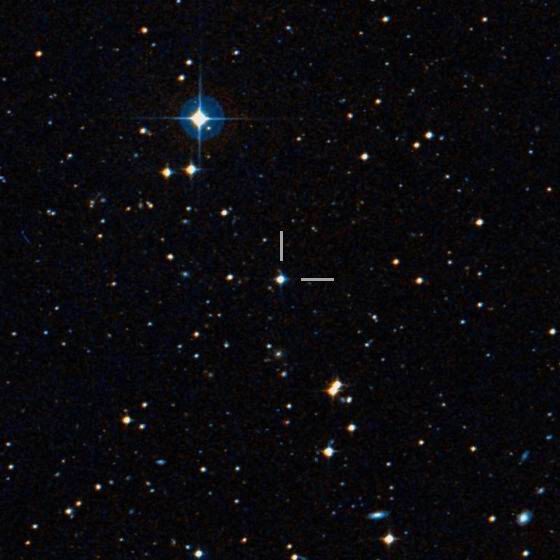
| Frankfurt Quasar Monitoring |
| PKS 2155-304 |
| Cross-Identifications | PKS J2158-3013, TXS 2155-304, PMN J2158-3013 3EG J2158-3023, EGRET J2155-304, 2155-304 EUVE J2158-30.2, 2MASS J21585206-3013321 H 2154-304, 1H 2156-304, XSS J21583-3004 2XMM J215852.0-301332, 1FGL J2158.8-3013 1ES 2155-304, 2A 2151-316, QSO B2155-304 RX J2158.8-3013, 1RXS J215852.2-301338 |
| Equat. coordinates | RA 21 58 52.0 DE -30 13 32 (J2000) |
| Constellation | Piscis Austrinus |
| Type | BL Lac (1) (6) / QSO (2) |
| Redshift | z=0.116 |
| Distance (2) (3) |
461 Mpc |
| Total mag range (mv) (4) (5) | 12.0 - 14.3 |
| Catalog Magnitude (1) | 13.09 |
| Absolute Magnitude (1) | -25.9 MB |
| Light Travel-Time (2) | 1.425 × 109 yrs |

Comparison stars
| star | B | V | Rc |
| 2 | 12.74 (0.01) |
12.05 (0.01) |
11.67 (0.01) |
| 3 | 13.90 (0.01) |
13.00 (0.01) |
12.47 (0.02) |
| 4 | 14.93 (0.01) |
14.28 (0.01) |
13.92 (0.02) |
| 5 |
16.01 (0.01) |
15.35 (0.03) |
15.01 (0.04) |


| PKS 2155-304 is a bright and variable BL Lac object in western Piscis
Austrinus, some 12° west of Alpha PsA, also known as Fomalhaut. PKS
2155-304 is one of the brightest extragalactic sources in the X–ray and
EUV bands, and is a prototype for the BL Lac class of objects. The
designation PKS 2155-304 refers to Parkes Radio Survey (PKS), where
this object was discovered as a flat spectrum radio source in 1969. In
1979, X-ray
emissions where detected by the HEAO 1-satellite (H). The
radio source, as well as the X-ray point source, where identified with
a
stellar object of B=14
mag.
Further spectroscopic investigations revealed a blue featureless
spectrum. Together with its flux variability and optical polarization, PKS
2155-304 was
clearly identified as a BL Lacertae type object. PKS 2155-304
was also identified as a gamma source by EGRET. Follow-up
high resolution optical photographs revealed the host galaxy of PKS
2155-304 as a giant
elliptical with an
apparent diameter of about 10". Furthermore, the host
galaxy resides
in a galaxy group/poor galaxy cluster. PKS 2155-304 is a moderately variable object on timescales from days to weeks, with a total optical range of about 2 magnitudes (12.0-14.3 mag). Due to its low declination of -30°, this object is a challenge for mid-northern observers. At maximum stage, visual observers need at least a 4- to 6-inch telescope to spot this stellar object. On average, an 8- to 10-inch telescope easily reveals this extragalactic variable. Even with large aperture telescopes, PKS 2155-304 remains a stellar object. CCD observers, as well as visual observers, shall use the comparison stars given above. Another sequence was published by Smith et al. (1991). One of the brightest optical states was detected by the Frankfurt Quasar Monitoring project in September 2006 at 12.0 mv (vsnet-alert 9002). This exceptionally bright state was accompanied by historically high fluxes of very high energy gamma-rays, first detected by H.E.S.S. on July 27, 2006 (ATEL #867). ____________
Locating
PKS
2155-304 is
easy by rendering a triangle, consisting of the star Mu (14) PsA in the
east, star Iota (9) PsA in the west, and PKS 2155-304 in the
north. 9°
to
the NE we find 11.6-mag spiral galaxy NGC 7314, which harbours an AGN
with Seyfert 1-spectrum. Two other deep sky showpieces can be visited
further distant. First
there is M30, a bright globular cluster, some 8° to the NE. And
finally, do not miss NGC 7293,
the famous "Helix Nebula", a large nearby planetary nebula, some 11° NW in Aquarius.
Far beyond our Milky Way galaxy, another bright quasar might attract the observers interest. PHL 1811 is a bright 14-mag stellar object at a distance of about 2.2×109 light-years, 20° north of PKS 2155-304. x |
| Bowyer, S., et al. 1984, ApJ, 278, 103; Optical observations of the BL Lacertae object PKS 2155-304 and implications regarding the X-ray absorption feature at 600-700 eV. Carini, M.T., Miller, H.R. 1992, ApJ, 385, 146; The optical variability of PKS 2155-304. Falomo, R., Pesce, J.E., Treves. A. 1993, ApJ, 411, 63; The environment of the BL Lacertae object PKS 2155-304. Fan, J.H., Lin, R.G. 2000, A&A, 355, 880; The variability analysis of PKS 2155-304. Farina, E.P., Fumagalli, M., et al. 2015, MNRAS 455, 618; The Cluster–Scale Environment of PKS 2155-304. Griffiths, R.E., Tapia, S., et al. 1979, ApJ, 234, 810; Optical and X-ray properties of the newly discovered BL Lacertae object PKS 2155-304 (= H2155-304). Hamuy, M., Maza, J. 1987, A&AS, 68, 383; UBVRI photometry of active galaxies. I. Observations. Hamuy, M., Maza, J. 1989, AJ, 97, 720; UBVRI photoelectric photometry in the fields of fifteen active galaxies. Heidt, J., Wagner, S.J., Wilhelm-Erkens, U. 1997, A&A, 325, 27; Optical and UV observations of the BL Lacertae object PKS 2155-304. Miller, H.R., McAlister, H.A. 1983, ApJ, 272, 26; The optical variability and spectrum of PKS 2155-304. Schwartz, D.A., Doxsey, R.E., et al., 1979, ApJ 229, 53; X-ray emitting BL Lacertae objects located by the scanning modulation collimator experiment on HEAO 1. Smith, P.S., Jannuzi, B.T., Elston, R. 1991, ApJS, 77, 67; UBVRI photometry of stars in the fields of X-ray selected BL Lacertae objects. Smith, P.S., Hall, P.B., et al. 1992, ApJ, 400, 115; Intensive optical monitoring of the BL Lacertae object PKS 2155-304. Urry, C.M., Maraschi, L., et al. 1992, AAS, 180, 10.02U; Intensive UV Monitoring of the BL Lac Object PKS 2155-304. Véron-Cetty, M.-P., Véron, P. 2001, A&A 374, 92; A Catalogue of Quasars and Active Nuclei: 10th edition. Véron-Cetty, M.-P., Véron, P. 2003, A&A 412, 399; A Catalogue of Quasars and Active Nuclei: 11th edition. Véron-Cetty, M.-P., Véron, P. 2006, A&A 455, 776; A Catalogue of Quasars and Active Nuclei: 12th edition. Véron-Cetty, M.-P., Véron, P. 2010, A&A 518, 10; A Catalogue of Quasars and Active Nuclei: 13th edition. Zhang, Y.H., Xie, G.Z. 1996, A&AS, 116, 289; CCD photometry and long-term optical variability of PKS 2155-304. |
| Links: Landessternwarte Heidelberg [vsnet-alert 9002] ATEL #867 AAVSO |
| home |